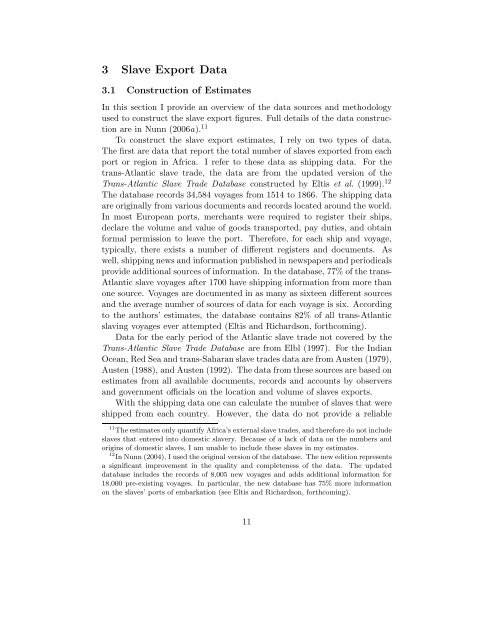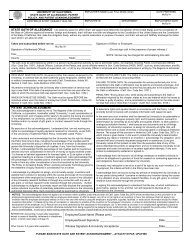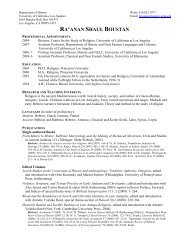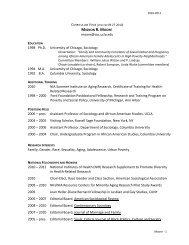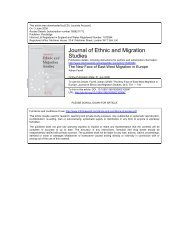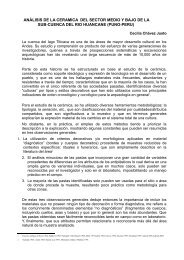The Long-Term Effects of Africa's Slave Trades - Social Sciences ...
The Long-Term Effects of Africa's Slave Trades - Social Sciences ...
The Long-Term Effects of Africa's Slave Trades - Social Sciences ...
Create successful ePaper yourself
Turn your PDF publications into a flip-book with our unique Google optimized e-Paper software.
3 <strong>Slave</strong> Export Data<br />
3.1 Construction <strong>of</strong> Estimates<br />
In this section I provide an overview <strong>of</strong> the data sources and methodology<br />
used to construct the slave export figures. Full details <strong>of</strong> the data construction<br />
are in Nunn (2006a). 11<br />
To construct the slave export estimates, I rely on two types <strong>of</strong> data.<br />
<strong>The</strong> first are data that report the total number <strong>of</strong> slaves exported from each<br />
port or region in Africa. I refer to these data as shipping data. For the<br />
trans-Atlantic slave trade, the data are from the updated version <strong>of</strong> the<br />
Trans-Atlantic <strong>Slave</strong> Trade Database constructed by Eltis et al. (1999). 12<br />
<strong>The</strong> database records 34,584 voyages from 1514 to 1866. <strong>The</strong> shipping data<br />
are originally from various documents and records located around the world.<br />
In most European ports, merchants were required to register their ships,<br />
declare the volume and value <strong>of</strong> goods transported, pay duties, and obtain<br />
formal permission to leave the port. <strong>The</strong>refore, for each ship and voyage,<br />
typically, there exists a number <strong>of</strong> different registers and documents. As<br />
well, shipping news and information published in newspapers and periodicals<br />
provide additional sources <strong>of</strong> information. In the database, 77% <strong>of</strong> the trans-<br />
Atlantic slave voyages after 1700 have shipping information from more than<br />
one source. Voyages are documented in as many as sixteen different sources<br />
and the average number <strong>of</strong> sources <strong>of</strong> data for each voyage is six. According<br />
to the authors’ estimates, the database contains 82% <strong>of</strong> all trans-Atlantic<br />
slaving voyages ever attempted (Eltis and Richardson, forthcoming).<br />
Data for the early period <strong>of</strong> the Atlantic slave trade not covered by the<br />
Trans-Atlantic <strong>Slave</strong> Trade Database are from Elbl (1997). For the Indian<br />
Ocean, Red Sea and trans-Saharan slave trades data are from Austen (1979),<br />
Austen (1988), and Austen (1992). <strong>The</strong> data from these sources are based on<br />
estimates from all available documents, records and accounts by observers<br />
and government <strong>of</strong>ficials on the location and volume <strong>of</strong> slaves exports.<br />
With the shipping data one can calculate the number <strong>of</strong> slaves that were<br />
shipped from each country. However, the data do not provide a reliable<br />
11 <strong>The</strong> estimates only quantify Africa’s external slave trades, and therefore do not include<br />
slaves that entered into domestic slavery. Because <strong>of</strong> a lack <strong>of</strong> data on the numbers and<br />
origins <strong>of</strong> domestic slaves, I am unable to include these slaves in my estimates.<br />
12 In Nunn (2004), I used the original version <strong>of</strong> the database. <strong>The</strong> new edition represents<br />
a significant improvement in the quality and completeness <strong>of</strong> the data. <strong>The</strong> updated<br />
database includes the records <strong>of</strong> 8,005 new voyages and adds additional information for<br />
18,000 pre-existing voyages. In particular, the new database has 75% more information<br />
on the slaves’ ports <strong>of</strong> embarkation (see Eltis and Richardson, forthcoming).<br />
11


